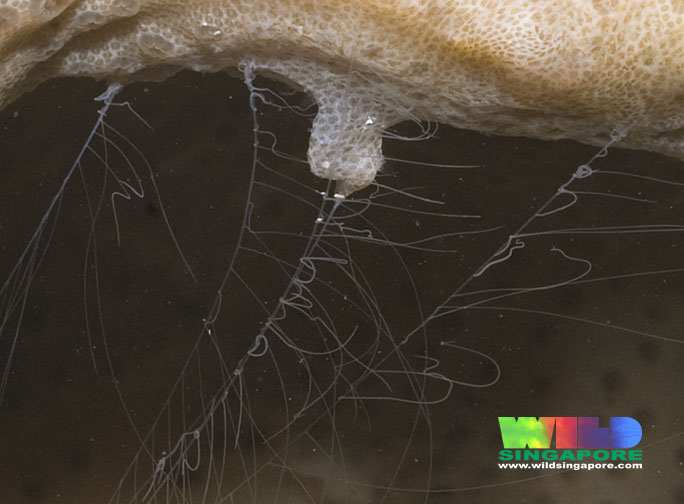Ctenophora is a phylum of marine animals most commonly referred to as comb jellies. You may have seen these in various documentaries, manifesting themselves as gelatinous geometric shapes fringed in movable cilia and psychedelic disco lights. This phylum is huge and diverse, comprising a myriad of classes and orders, each with their own collection of genera and species. Many of these are poorly studied and remain undescribed, spanning the vast oceans worldwide from shallow bays to abyssal depths. Almost all of them have something in common though, and that is their predatory nature. [Photo credit above: Wild Singapore]
Depending on the species and size, ctenophores feed on a variety of things from microscopic zooplankton to small fish and crustacean. Most textbook examples of ctenophores feature a pair of retractable tentacles fringed along the entire length with tentilla (smaller tentacles), each one covered in colloblasts (sticky cells that capture prey). While you’re unlikely to encounter the stereotypical comb jelly in your home, do remember that this is a huge phylum, and with such a giddying array of examples, surely some will find a way to sneak into your replica reef.

Platyctenida is the only benthic example of the phylum Ctenophora, and this order is placed in the class tentaculata. Platyctenids have dorsalventrally flattened, oval bodies that look more like nudibranchs or flatworms compared to their pelagic counterparts. All but one species possess the characteristic ciliated comb rows, and all possess the pair of tentilla bearing tentacles equipped with collocytes for feeding. Platyctenida contains five families, of which, coeloplanidae is home to the genus Coeloplana. This genus is the most commonly encountered shallow water benthic ctenophore, and the genus finds its way into our home aquariums rather readily.

Most species of Coelaplana are small etcosymbionts associated with corals or invertebrates. They plaster onto their host in a manner similar to a flatworm, and move about slowly by everting their pharynx and pulling themselves forward. Many of them bear similar color patterns to their host, and are highly camouflaged. Despite the drastic difference in appearances, they share plesiomorphic characteristics common to nearly all representatives of Ctenophora.

If you’re a keen observer of your reef, you may have noticed long ramifying thread like filaments extending and retracting from various corals, especially soft corals. These are not appendages belonging to your cnidarian, but rather, are the feeding tentacles of the benthic Coelaplana. If you’ve seen this and have always wondered what they are, now you know.

The tentacular appendages bear on their ventral side, numerous tentilla, and each tentacles extends from and retracts into a tentacular sheath. This appendage is covered in an epidermis, of which is made of six cell types. Two types of gland cells (mucous and granular gland), two types of sensory cells (ciliated and hoplocytes), covering cells and collocytes make up the epidermis. The collocytes are found exclusively on the tentilla, and are sticky and used for catching prey. The tentacular core is made up of a fibrillar matrix, the mesoglea, and two types of smooth muscle cells.
The extension of the feeding tentacles are passive, while the retraction is an active phenomenon brought upon by the contraction of both muscle types. Once contracted and withdrawn, the rebound elasticity of the mesogleal fibres within help to push the tentacles back out slightly, and is subsequently extended via drag forces in the water column. The movement of the water in the surrounding matrix is critical in enabling the tentacles to extend to their maximum capacity, seeing as this process is passive and uncontrollable. Once the tentacles are fully exposed to the water column, the gland cells, sensory cells and collocytes are exposed, enabling the Coeloplana to capture its prey. This triggers the tentacles to contract via the two muscle types, and the process repeats itself. The video above of a benthic ctenophore, of unknown genus, shows this process very well.
Coeloplana are also remarkable in possessing the ability to reproduce both sexually and asexually. This allows the species to colonise large areas quickly, often smothering their host with high rates of infestation.

The benthic ctenophore Lyrocteis imperatoris above is a probable offspring produced asexually from an individual collected from 400ft in Anilao, Philippines. The specimen is currently residing in the California Academy of Sciences, and provides valuable insights into the weird and mysterious world of ctenophores. Their resilience and adaptability have allowed this phylum to colonise almost all habitat types through a spectrum of different species in various forms. Even your home aquarium, where their presence have gone incognito.
References:
Matsumoto, G.I. & Gowlett-Holmes, K.L. 1996 Coeloplana scaberiae sp. nov., a new benthic ctenophore (Ctenophora: Platyctenida: Coeloplanidae) from South Australia. Records of the South Australian Museum 29(1): 33-40.
Eeckhaut, I. & Flammang, P. & Lo Blue, C. & Jangoux, M. 1997 Functional morphology of the tentacles and tentilla of Coeloplana bannworthi (Ctenophora, Platyctenida), an ectosymbiont of Diadema setosum (Echinodermata, Echinoida). Zoomorphology 11(3): 165-174.



